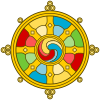
Back تارا (بوذية) Arabic Тара (будизъм) Bulgarian তারা (বৌদ্ধধর্ম) Bengali/Bangla འཕགས་མ་སྒྲོལ་མ་ལ་བསྟོད་པ། Tibetan Дара Эхэ BXR Tara (budisme) Catalan Tárá Czech Tara (Bodhisattvi) German Tara (budhismo) Esperanto Tara (budismo) Spanish
| Tārā | |
|---|---|
 13th century Tibetan painting of Green Tara | |
| Sanskrit | तारा
Tārā |
| Chinese | (Traditional) 多羅菩薩 (Simplified) 多罗菩萨 (Pinyin: Duōluó Púsà) 度母 (Pinyin: Dùmǔ) |
| Japanese | 多羅菩薩 (romaji: Tara Bosatsu) |
| Korean | 다라보살
(RR: Dara Bosal) |
| Mongolian | Ногоон дарь эх |
| Tagalog | Tala |
| Thai | พระนางตารา |
| Tibetan | རྗེ་བརྩུན་སྒྲོལ་མ།། |
| Vietnamese | Đa La Bồ Tát Độ Mẫu |
| Information | |
| Venerated by | Mahāyāna, Vajrayāna |
| Part of a series on |
| Tibetan Buddhism |
|---|
 |
Tara (Sanskrit: तारा, tārā; Standard Tibetan: སྒྲོལ་མ, dölma), Ārya Tārā (Noble Tara), also known as Jetsün Dölma (Tibetan: rje btsun sgrol ma, meaning: "Venerable Mother of Liberation"), is an important female Buddha in Buddhism, especially revered in Vajrayana Buddhism and Mahayana Buddhism. She may appear as a female bodhisattva in Mahayana Buddhism.[1] In Vajrayana Buddhism, Green Tara is a female Buddha who is a consort of Amoghasiddhi Buddha. Tārā is also known as a saviouress who hears the cries of beings in saṃsāra and saves them from worldly and spiritual danger.[2]
In Vajrayana, she is considered to be a Buddha, and the Tārā Tantra describes her as "a mother who gives birth to the buddhas of the three times" who is also "beyond saṃsāra and nirvāṇa."[3] She is one of the most important female deities in Vajrayana and is found in sources like the Mañjuśrīmūlakalpa, and the Guhyasamāja Tantra.[4] Key Indic Vajrayana texts which focus on Tārā include the Tantra Which is the Source for All the Functions of Tārā, Mother of All the Tathagatas (Skt. Sarvatathāgatamātṛtārāviśvakarmabhavanāmatantra) and Tārā’s Fundamental Ritual Text (Tārāmūlakalpa).[5][3]
Both Green and White Tārā remain popular meditation deities or yidams in Tibetan Buddhism, and Tara is also revered in Newar Buddhism. Tārā is considered to have many forms or emanations, while Green Tara emanates twenty-one Tārās, each with different attributes—colors, implements, and activities such as pacifying (śānti), increasing (pauṣṭika), enthralling (vaśīkaraṇa), and wrathful (abhicāra).[2] The Green Tara (or "blue-green", Skt. Samayatara or śyāmatārā) remains the most important form of the deity in Tibetan Buddhism.[6][7] A practice text entitled Praises to the Twenty-One Taras is a well known text on Tara in Tibetan Buddhism and in Tibet, recited by children and adults, and is the textual source for the twenty-one forms of Green Tārā.
The main Tārā mantra is the same for Buddhists and Hindus alike: oṃ tāre tuttāre ture svāhā. It is pronounced by Tibetans and Buddhists who follow the Tibetan culture as oṃ tāre tu tāre ture soha. The literal translation would be "Oṃ O Tārā, I pray O Tārā, O Swift One, So Be It!"
- ^ Buddhist Deities: Bodhisattvas of Compassion
- ^ a b "The Tantra on the Origin of All Rites of Tārā, Mother of All the Tathāgatas / Introduction / 84000 Reading Room". 84000 Translating The Words of The Buddha. Retrieved 13 January 2024.
- ^ a b James B. Apple, "Atiśa’s System of Twenty-One Tārās", Revue d’Etudes Tibétaines, no. 66, Avril 2023, pp. 424-463.
- ^ Kaur, Gurmeet (January 2022). "Tara in Vajrayana Buddhism: A Critical Content Analysis". Feminist Theology. 30 (2): 210–221. doi:10.1177/09667350211055444. ISSN 0966-7350. S2CID 244052426.
- ^ Beyer (1973), p. 13.
- ^ Cite error: The named reference
:2was invoked but never defined (see the help page). - ^ Willson (1996), pp. 124–166.